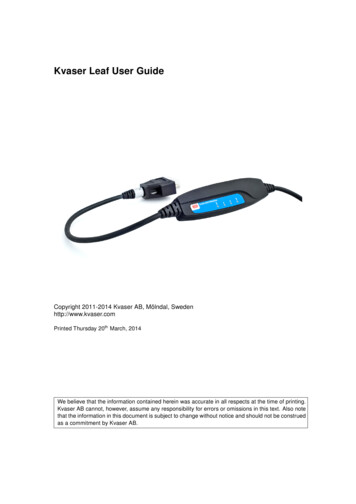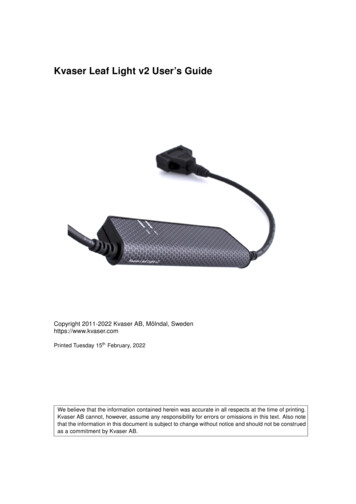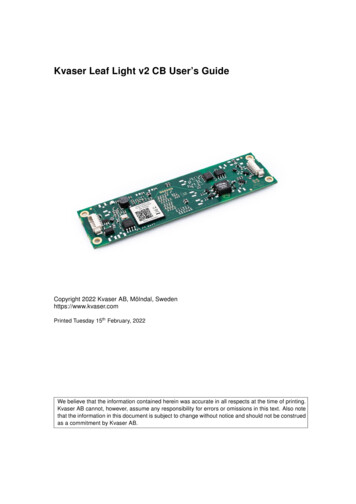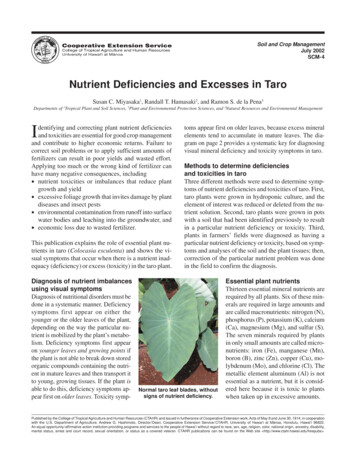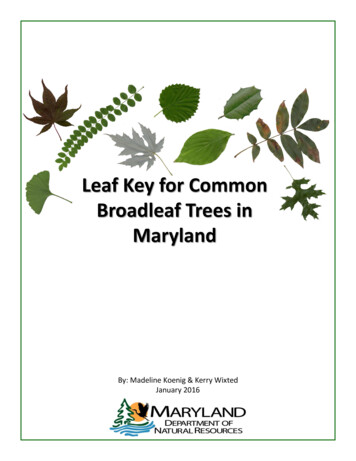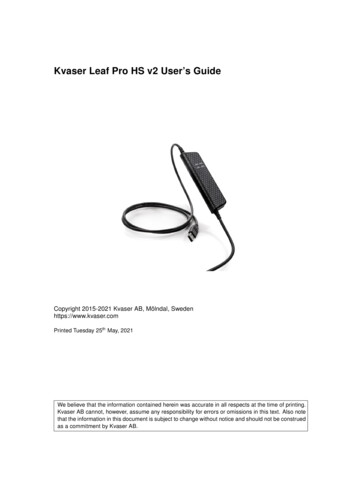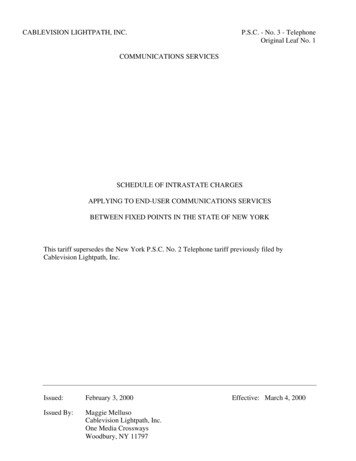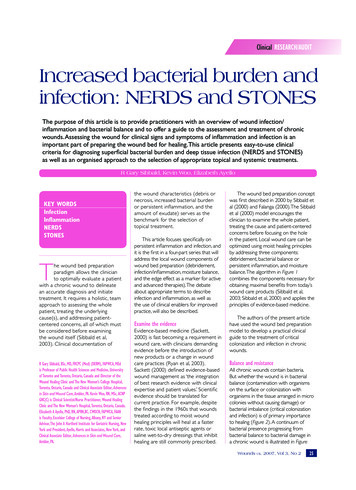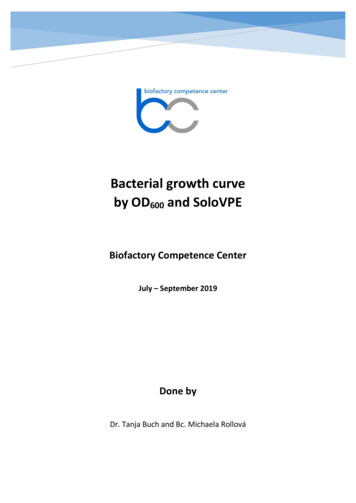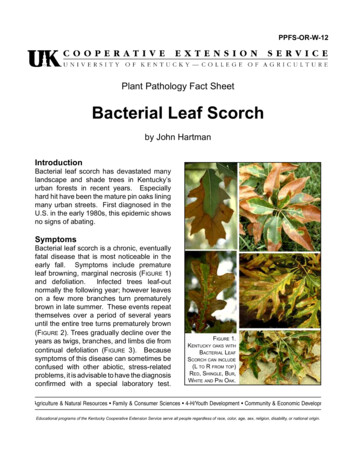
Transcription
PPFS-OR-W-12Plant Pathology Fact SheetBacterial Leaf Scorchby John HartmanIntroductionBacterial leaf scorch has devastated manylandscape and shade trees in Kentucky’surban forests in recent years. Especiallyhard hit have been the mature pin oaks liningmany urban streets. First diagnosed in theU.S. in the early 1980s, this epidemic showsno signs of abating.SymptomsBacterial leaf scorch is a chronic, eventuallyfatal disease that is most noticeable in theearly fall. Symptoms include prematureleaf browning, marginal necrosis (Figure 1)and defoliation.Infected trees leaf-outnormally the following year; however leaveson a few more branches turn prematurelybrown in late summer. These events repeatthemselves over a period of several yearsuntil the entire tree turns prematurely brown(Figure 2). Trees gradually decline over theyears as twigs, branches, and limbs die fromcontinual defoliation (Figure 3). Becausesymptoms of this disease can sometimes beconfused with other abiotic, stress-relatedproblems, it is advisable to have the diagnosisconfirmed with a special laboratory test.Figure 1.Kentucky oaks withBacterial LeafScorch can include(L to R from top)Red, Shingle, Bur,White and Pin Oak.Agriculture & Natural Resources Family & Consumer Sciences 4-H/Youth Development Community & Economic DevelopmentEducational programs of the Kentucky Cooperative Extension Service serve all people regardless of race, color, age, sex, religion, disability, or national origin.
leaf scorch symptoms. Some researchersworking with this disease suggest that leafscorch symptoms are more severe duringtimes when other stresses are placed onthe tree. Timing of symptom developmentin mid- to late summer in urban trees is oftenassociated with various moisture and heatstresses occurring that season.Host Range and LocationFigure 2.Bacterial leaf scorch causes prematurebrowning of pin oak (L) compared to unaffected tree (R).Leaf tissue can be tested for the presence ofthe bacterium at the University of KentuckyPlant Disease Diagnostic Laboratory.Cause and SpreadBacterial leaf scorch is caused by the bacteriumXylella fastidiosa. This bacterium is spread byleafhoppers and treehopper insects, althoughit does not appear to be spread from treeto tree very rapidly. Nevertheless, in someneighborhoods where the disease has beenpresent for many years, a high proportion ofmature oaks may show symptoms of bacterialleaf scorch (Figure 4). Little is known aboutwhich of these leafhopper vectors are activein Kentucky. There is some evidence that X.fastidiosa is present in symptomless shrubs,grasses and weedsin the landscape.Thus, leafhoppersmay not necessarilypass the diseasefrom tree to tree, butmay be acquiringthe bacterium fromother hosts.Figure 3. Pin Oak withbranch dieback resultingBacterialLeaf Scorch disease.from chronicThepathogeninfects the xylemwhere it partiallyblocks the flowof water to theleaves, resulting inBacterial leaf scorch is found throughoutmuch of the eastern and southern U.S. InKentucky, it is present in landscape treesin many urban areas, including Paducah,Madisonville, Owensboro, Bowling Green,Somerset, Louisville, and Lexington. Thisdisease has not been detected in Kentucky’sforest trees.Figure 4. Street tree Pin Oaks begin to show declinedue to Bacterial Leaf Scorch (L), with completelosses occuring a few years later (R).Bacterial leaf scorch has been commonlyobserved in oaks, especially pin oak andred oak, and in sycamore in Kentucky. It isalso occasionally found here in red maple,sugar maple, silver maple, London plane,hackberry, mulberry, elm, and sweetgum.Refer to Table 1 for a list of known hosts, andFigures 1, 5 and 6 for typical symptoms.Disease ManagementThere is no cure for bacterial leaf scorch,so one should expect diseased trees to
Figure 5. Symptoms ofBacterial Leaf Scorch onSilver Maple (above) andSugar Maple (L). RedMaples and Boxelders arealso susceptible.be gradually lost over the years. Becauseinfected trees decline gradually, it may be 5to 10 years before there are many dead limbsand branches present. In the meantime, treeowners can provide good growing conditionsfor the trees to prolong their survival and toenhance their aesthetic value. Pruning. Newly infected trees can bemade to look somewhat presentable for a fewmore years if the dead wood is pruned out. Wateringtrees.Kentucky summerweather can sometimes be hot andaccentuated by periods of drought lastinganywhere from a week to several months. Astudy conducted by the University of Marylanddemonstrated a possible correlation betweenbacterial leaf scorch and water stress. Basedon their results, Kentucky tree owners andlandscape managers may be able to prolongthe lives of their scorch-infected trees byapplying supplemental water during the hot,dry parts of the growing season. Tree–injections. There are commercialtree-injection products containing the antibioticoxytetracyclene which are sold and usedfor the management of bacterial leaf scorchdisease. Injections, which are made into theroot flare at the base of the tree, may providetemporary remission of the symptoms. Tobe effective, however, the antibiotic wouldneed to be re-injected, perhaps annually ormore often. In Kentucky, we have observedsymptoms in pin oaks and red oaks treatedwith antibiotic injections can be delayed byseveral weeks. These treatments do not cureinfected trees, but they may prolong the lifeof the tree. Researchers with the NationalPark Service who are combating this diseasein elms on the Mall in Washington, D.C. havenot found injections to be an effective longterm solution.Research has also shown that injections bythemselves can cause long-term problems fortrees since the injection holes may becomeports of entry for wood rotting organisms.Even when decay organisms do not invade,areas of the wood behind the injection pointare rendered discolored and non-functional.If frequent re-treatment is required, injectionsare likely to cause considerable damageover the life of a tree.In summary, while treatments may prolongtree life, long term research results are notavailable and injections inherently damagetrees. Thus, the choice to use of antibioticinjections for bacterial leaf scorch would varywith the wishes and objectives of the tree owner. Tree replacement. The best remedyfor bacterial leaf scorch is tree replacement.Begin planting non-susceptible replacementtrees early so that they will attain a reasonablesize before the diseased ones are removed.When replanting, it is not necessary to uselarge transplants. Often, smaller nurserystock becomes established more quicklythan larger nursery stock so that after 10years, their relative sizes might not be muchdifferent. During the several years followingtree planting, make provisions for watering thetrees regularly, applying mulch periodically,
and pruning trees correctly so that good,strong, branch structure is established whenthe trees are young.To maintain species diversity and to preventcatastrophictreelossesduetodiseases or insects,avoid planting all thesame tree species ina neighborhood, ora community. Selecttrees that do well inbefore purchasing plants. If a selection willbe used as a street tree, it should first bedetermined if that species is permitted by thelocal municipal arborist or tree authorities.Additional ResourcesThe following University of Kentuckyresources can be helpful in selectingappropriate replacement trees.Available at County Extension Offices(publications) Large Trees, the Giants of Kentucky’sLandscape by Fountain, W. M., Witt, M. L.,and Swintosky, J. S. (1996). 45 p. Medium-Sized Trees for KentuckyLandscapes by Witt, M. L., Fountain, W. M.,and Swintosky, J. S. (1995). 42 p. Small Trees for Urban Spaces in Kentuckyby Witt, M. L., Nash, L. J., Fountain, W. M.,and Crankshaw, N. (1995). 40 p.Figure 6. Other treessusceptible to BacterialLeaf Scorch include (topto bottom) Sycamore,Ginkgo and SweetgumKentucky, such asthose included in theUniversity of Kentuckymaterials listed in Additional Resources.Refer to Table 2 for a list of large-sized treesthat have not yet been affected by bacterialleaf scorch.These trees might makesuitable replacements for trees lost alongstreets, in parks and in yards. Some mayhave other drawbacks. Readers are urgedto learn more about the habits of these treesAvailable for use at County ExtensionOffices (compact disks) Large Trees for Kentucky Landscapes byRobert Geneve and Christy Cassady Small and Medium Trees for KentuckyLandscapes by Robert Geneve and ChristyCassadyAvailable on the Web Native Trees of Kentucky (Department kytreewebsite/treeprofiles/treelist.htm(Issued July 2007)
Table 1. Tree species known to be susceptible to bacterial leaf scorch.Family or groupDogwoodElmGingko (Figure 6)HackberryMaple (Figure 5)MulberryOak (Figure 1)Sweetgum (Figure 6)Sycamore (Figure 6)Common nameScientific nameBluejack oakBur oak*Chestnut oakEnglish oak**Laurel oakLive oakNorthern red oak*Pin oak*Post oakScarlet oak*Shingle oak*Shumard oakSouthern red oakSwamp chestnut oak**Swamp white oakTurkey oakWater oakWhite oak*Willow oak*American sweetgum*American sycamore*London plane*Q. incanaQ. prinusQ. macrocarpaQ. roburQ. laurifoliaQ. virginianaQ. rubraQ. palustrisQ. stellatQ. coccineaQ. imbricariaQ. shumardiiQ. falcateQ. michauxiiQ. bicolorQ. laevisQ. nigraQ. albaQ. phellosLiquidambar styracifluaPlatanus occidentalisP. x acerifoliaFlowering dogwoodOriental dogwood**American elm*Maidenhair tree**Common hackberry*Box elder*Red maple*Silver maple*Sugar maple*White mulberry*Black oakCornus floridaC. kousaUlmus americanaGingko bilobaCeltis occidentalisAcer negundoA. rubrumA. saccharinumA. saccharumMorus albaQuercus velutina* Bacterial leaf scorch is present in Kentucky on these trees.** Bacterial leaf scorch is present in Kentucky, but not in other states, on these trees.
Table 2. Tree species that have not yet been affected by bacterial leaf scorchFamily or groupAlderAshBlack gumBuckeyeBeechCatalpaCoffeetreeEuropean black alderBlue AshWhite ashGreen ashTupeloYellow buckeyeEuropean beechNorthern catalpaKentucky CoffeetreeCork treeAmur cork treeElmHackberryHickoryOsage-OrangeLacebark or Chinese elmSugar hackberryShagbark hickoryShellbark hickoryPignut hickoryKatsuratreeAmerican lindenLittleleaf lindenCucumbertreeBlack mapleChinkapin oakSawtooth oakHedge-appleSassafrasTulip poplarZelkovaCommon sassafrasTuliptreeJapanese zelkovaKatsuraLindenMagnoliaMapleOak1Common nameScientific nameAlnus glutinosa, and cultivarsFraxinus quadrangulataF. americana and cultivarsF. pennsylvanica and cultivars 1Nyssa sylvaticaAesculus flavaFagus sylvatica and cultivarsCatalpa speciosaGymnocladus dioicusand fruitless male cultivarsPhellodendron amurenseand fruitless male cultivarsUlmus parvifolia 2Celtis laevigata 3Carya ovataC. laciniosaC. glabraCercidophyllum japonicumTilia americanaT. cordataMagnolia acuminataAcer saccharum subsp. nigrum 4Quercus muehlenbergii 5Q. acutissimaMaclura pomiferaand fruitless male cultivarsSassafras albidumLiriodendron tulipiferaZelkova serrata and cultivarsAsh might not be a good choice due to the impending invasion of the emerald ash borer.Although bacterial leaf scorch is a serious problem of American elm, its effect on Chinese elm is not known.3Sugar hackberry may be a risky choice since the disease is present on common hackberry.4Although the disease has not been detected on black maple, the fact that it occurs on four other maples inKentucky makes this a risky choice.5These oak species have not been observed with bacterial leaf scorch. However, the fact that it occurs onmost other oaks makes them risky choices.2
Somerset, Louisville, and Lexington. This disease has not been detected in Kentucky's forest trees. Bacterial leaf scorch has been commonly observed in oaks, especially pin oak and red oak, and in sycamore in Kentucky. It is also occasionally found here in red maple, sugar maple, silver maple, London plane, hackberry, mulberry, elm, and sweetgum.
